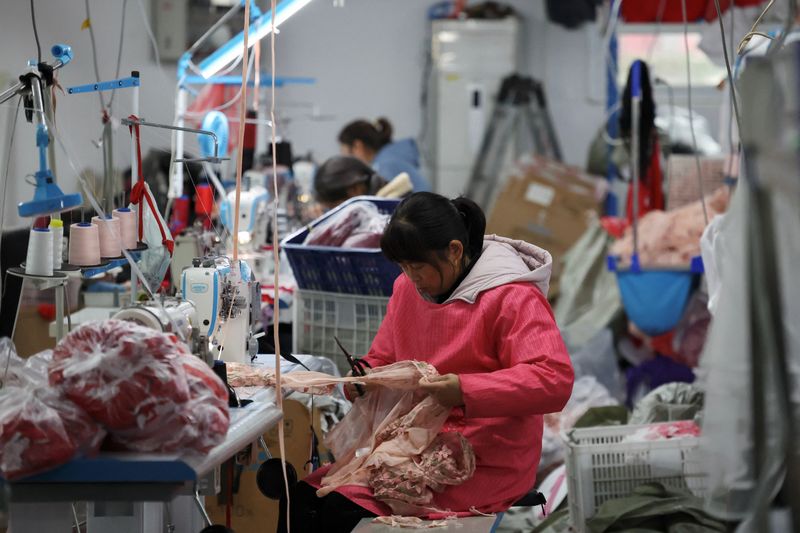By Joe Money
BEIJING (Reuters) -China’s manufacturing exercise barely grew in December although companies and development recovered, an official survey confirmed on Tuesday, suggesting coverage stimulus is trickling into some sectors because the economic system braces for brand new commerce dangers.
The Nationwide Bureau of Statistics (NBS) buying managers’ index (PMI) slowed to 50.1 in December from 50.3 a month prior, staying above the 50-mark separating progress from contraction however lacking a median forecast of fifty.3 in a Reuters ballot.
China’s $18 trillion economic system has struggled to get well from the pandemic amid weak consumption and funding, and a protracted property disaster. Nonetheless, policymakers hope a latest blitz of fiscal and financial measures will spark a turnaround within the property market, which has dragged on the broader economic system.
Improved home demand may gain advantage producers amid a world financial slowdown, lowering the affect of U.S. President-elect Donald Trump’s proposed new tariffs on Chinese language items.
“The worst part of overcapacity seems to be over, businesses are receiving more orders,” stated Xu Tianchen, senior economist on the Economist Intelligence Unit. “But there is a high risk of activity slowing again if stimulus subsides.”
“The bottom line is the stimulus needs to be sustained.”
The brand new orders sub-index of the manufacturing PMI rose to 51.0 this month – an eight-month excessive – up from 50.8 in November. However the brand new export orders, employment, manufacturing unit gate costs sub-indices all remained firmly in detrimental territory, the NBS stated.
Blended industrial output and retail gross sales knowledge for November launched earlier this month underscore how difficult it is going to be for Beijing to mount a sturdy financial restoration in 2025. Authorities advisers are recommending the economic system preserve a progress goal of round 5.0% subsequent 12 months and that policymakers ramp up consumer-focused stimulus.
The non-manufacturing PMI, which incorporates development and companies, rose to 52.2 this month, after it slowed to 50.0 in November. The NBS attributed the uptick to progress in China’s monetary companies, telecommunications and journey sectors.
Following the info, China’s blue chip index fell 0.6%, whereas Hong Kong’s rose 0.35%.
KEEP STIMULUS COMING
Analysts at Nomura warned it was too early to say whether or not assist measures comparable to a shopper items trade-in scheme and an easing of property buy restrictions, for instance, had achieved sufficient to get the economic system on a extra even keel for the long run.
“The surge in purchases of durable goods might be followed by notable payback effects. The property sector has yet to truly recover, weighed on by the debt overhang of distressed developers,” they stated in a word, including that Trump’s return to the White Home poses a danger to Chinese language exporters.
Trump has vowed to impose a ten% tariff on Chinese language items to compel Beijing to halt the trafficking of Chinese language-made chemical compounds utilized in fentanyl manufacturing. He additionally threatened tariffs in extra of 60% on Chinese language items throughout his marketing campaign, posing a significant progress danger for the world’s high exporter of products.
At an agenda-setting assembly earlier this month, policymakers pledged to extend the funds deficit, subject extra debt and loosen financial coverage to assist financial progress.
The World Financial institution final week raised its progress forecasts for China for 2024 and 2025, however warned that subdued family and enterprise confidence, together with headwinds within the property sector, would weigh on financial progress subsequent 12 months. At its peak in 2021, the sector accounted for round 1 / 4 of the economic system.
The non-public sector Caixin manufacturing unit survey will likely be launched on Thursday and analysts anticipate its studying to edge as much as 51.7.
China’s official December composite PMI, which incorporates each manufacturing and companies exercise, rose to 52.2 in December, up from 50.8 a month prior.

“Increased policy support towards the end of the year has clearly provided a near-term boost to growth,” stated Gabriel Ng, assistant economist at Capital Economics.
“But the boost probably won’t last more than a few quarters, with Trump likely to follow through on his tariff threat next year and persistent structural imbalances still weighing on the economy.”




